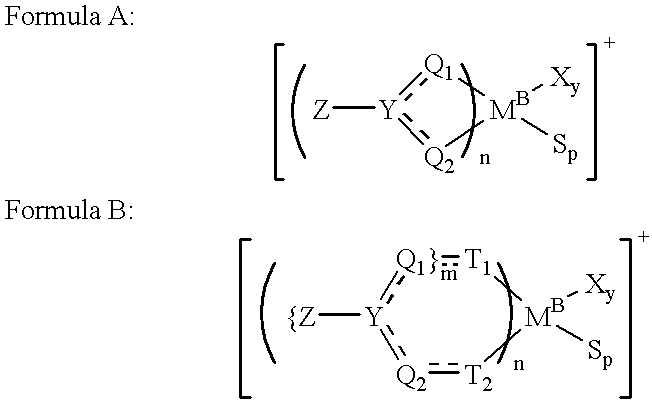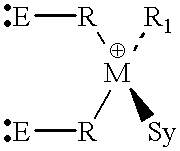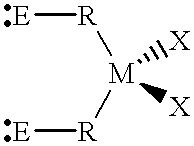Process for the production of stereoregular polymers and elastomers of alpha-olefins and certain novel catalysts therefor
a technology of alpha-olefins and polymers, applied in the direction of catalyst activation/preparation, physical/chemical process catalysts, chemical/physical processes, etc., can solve the problems of limited molecular weight, molecular weight distribution and tacticity control, and unsuitable applications, and achieve the effect of efficient polymerization of alpha-olefins
- Summary
- Abstract
- Description
- Claims
- Application Information
AI Technical Summary
Benefits of technology
Problems solved by technology
Method used
Image
Examples
example 2
Synthesis of dichloro-bis(N,N'-trimethylsilyl-4-methyl-benzamidinato)-Zr(I-V)
[0119] To a solution of 5.96 g (15.8 mmol) of ZrCl.sub.4(THF).sub.2 in 130 ml of THF, a solution of 12.66 g (31.6 mmol) of Li[4-CH.sub.3C.sub.6H.sub-.5C(NSi((CH.sub.3).sub.3).sub.2]-TMEDA in 100 ml of THF was added while stirring. The reaction mixture was stirred overnight at room temperature and the solvent was removed under vacuum. The residue obtained was extracted with 80 ml of toluene and the precipitated LiCl was removed by filtration through a thin layer of Celite filter-aid. The clear filtrate was evaporated to dryness, washed with 20-30 ml of hexane and dried under vacuum for about 12 hours, obtaining 9.7 g of a yellow product (corresponding to a yield of 86%).
example 3
Synthesis of dichloro-bis(N,N'-dicyclohexylbenzamidinato)-titanium(IV)
[0120] To a solution of 5.27 g (15.8 mmol) of TiCl.sub.4(THF).sub.2 in 130 ml of THF, a solution of 9.97 g (34.3 mmol) of Li[C.sub.6H.sub.5C(NC.sub.-6H.sub.11).sub.2] in 100 ml of THF was added while stirring. The reaction mixture was stirred overnight at room temperature and the solvent was removed under vacuum. The residue obtained was extracted with 80 ml of toluene and the precipitated LiCl was removed by filtration through a thin layer of Celite filter-aid. The clear filtrate was evaporated to dryness, washed with 20-30 ml of hexane and dried under vacuum for about 12 hours, obtaining 9.2 g of a red product (corresponding to a yield of 84.5%).
example 4
Synthesis of dichloro-bis(N,N'-diisopropylbenzamidinato)-zirconium(IV)
[0121] To a solution of 7.54 g (20.0 mmol) ZrCl.sub.4(THF).sub.2 in 130 ml THF, a solution of 8.41 g (40.0 mmol) of Li[C.sub.6H.sub.5C(NC.sub.3H.sub-.7).sub.2] in 100 ml of THF was added dropwise at room temperature over a period of 15 minutes. The reaction mixture was stirred overnight at room temperature. The solvent was removed under vacuum, and the residue extracted with 80 ml of toluene. The precipitated LiCl was removed by filtration through a thin layer of Celite filter-aid. The clear filtrate was evaporated to dryness, washed with hexane (20-30 ml) and dried under vacuum for about 12 hours, thus obtaining 6.78 g (corresponding to a yield of 60%) of a pale yellow, crystalline powder.
PUM
| Property | Measurement | Unit |
|---|---|---|
| molecular weight | aaaaa | aaaaa |
| elongation | aaaaa | aaaaa |
| pressure | aaaaa | aaaaa |
Abstract
Description
Claims
Application Information
 Login to View More
Login to View More - R&D
- Intellectual Property
- Life Sciences
- Materials
- Tech Scout
- Unparalleled Data Quality
- Higher Quality Content
- 60% Fewer Hallucinations
Browse by: Latest US Patents, China's latest patents, Technical Efficacy Thesaurus, Application Domain, Technology Topic, Popular Technical Reports.
© 2025 PatSnap. All rights reserved.Legal|Privacy policy|Modern Slavery Act Transparency Statement|Sitemap|About US| Contact US: help@patsnap.com



